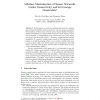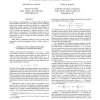65 search results - page 9 / 13 » A Tree-Turn Model for Irregular Networks |
DCOSS
2006
Springer
13 years 11 months ago
2006
Springer
In this paper, we study the fundamental limits of a wireless sensor network's lifetime under connectivity and k-coverage constraints. We consider a wireless sensor network wit...
ICASSP
2008
IEEE
14 years 1 months ago
2008
IEEE
The estimation error performance of Gaussian belief propagation based distributed estimation in a large sensor network employing random sleep strategies is explicitly evaluated fo...
TIME
2008
IEEE
14 years 1 months ago
2008
IEEE
The movement in public transport networks is organized according to schedules. The real-world schedules are specified by a set of periodic rules and a number of irregularities fr...
TOG
2002
13 years 7 months ago
2002
Surface geometry is often modeled with irregular triangle meshes. The process of remeshing refers to approximating such geometry using a mesh with (semi)-regular connectivity, whi...
IWCMC
2006
ACM
14 years 1 months ago
2006
ACM
Wireless sensors use low power radio transceivers due to the stringent constraints on battery capacity. As a result, radio transmission with wireless sensors is unreliable. Furthe...


